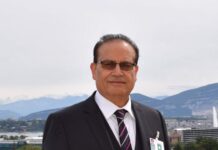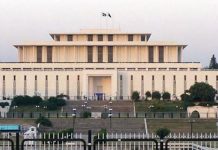By: Maryam Wakeel
At the time of independence, Pakistan’s economy was predominantly agrarian, contributing over 50% to the GDP, with minimal industrial presence. The lack of essential infrastructure further undermined Pakistan’s economic sovereignty. The government’s focus on industrial development led to the neglect of agriculture in the early years. This neglect is evident in the agricultural growth rate, which was half that of the population growth rate. Contributing factors to this slow growth included water shortages and the impacts of partition, such as the water dispute with India and fluctuating rainfall and floods in the 1950s. Between 1947 and 1952, Pakistan’s average GDP growth was 3%, but the outbreak of the Korean War in 1952 boosted demand for goods, increasing GDP growth to 9%. Despite a global recession following the Korean War, Pakistan’s economy remained resilient due to its position as the sole exporter of jute at the time. The sustained high growth rate in the industrial sector during this period was achieved through deliberate policies that encouraged private industry investment and attracted substantial foreign aid. Import substitution and excessive protectionism also played crucial roles in maintaining the high growth rate in this sector.
The second decade of Pakistan’s history was characterized by the dictatorial regime of Field Marshal Ayub Khan. The 1960s were marked by robust economic performance. The Second Five Year Plan (1960-1965) aimed for a GDP growth of 20% over five years, exceeding the modest target of 15% set in the First Five Year Plan. The Third Plan (1965-1970) was formulated with great optimism, setting an annual growth target of 6.5%. The early years of the decade saw substantial growth in large-scale manufacturing, with an average annual increase of 16.9% between 1960 and 1965. However, the GDP growth rate declined to 3.1% in the latter half of the 1960s due to the war with India, though it subsequently recovered to 9.8% by 1970.
Bhutto initiated several socialist economic reforms aimed at stimulating Pakistan’s economic growth. A key component of these reforms was the process of nationalization. Initially, the policy targeted large firms, and within two years, all private banks, small manufacturing units, and colleges were nationalized without compensation to their former owners. Although intended to uplift the poor, these reforms quickly proved counterproductive. The inefficiency and incompetence of the nationalized institutions in the subsequent years demonstrated that nationalization was not in the national interest. Bhutto introduced land reforms aimed at enhancing the social and economic status of rural populations, over 80% of whom were directly involved in agriculture. Bhutto also announced a Labor Policy in February 1972, designed to elevate labor dignity, establish mechanisms for striking, promote labor-employer adjudication in labor courts, and extend material benefits to workers. This policy provided some relief through increased wages and welfare measures, including minimum wage hikes, injury compensation, old age benefits, and free education and medical facilities.
During Zia-ul-Haq’s regime, the economic growth rate averaged 6.6% annually. There was a significant increase in remittances, although this did not translate into a higher rate of savings and investments. Agricultural growth, while improved compared to previous years, remained relatively low. The manufacturing sector, however, experienced substantial growth, averaging 9% per year. This growth was driven by extensive public sector investments initiated during Bhutto’s era, the introduction of a flexible exchange rate policy, increased export rebates, and assurances against future nationalization. Special industrial zones were established to attract private investment, and regular currency adjustments positively impacted trade.
Despite these advancements, the national debt burden increased significantly, with interest payments rising from 1.9% of GDP in 1976 to 4.9% in 1987, primarily due to high-cost domestic borrowing. As part of his Islamization policy, Zia introduced an Islamic economic system, which included the establishment of the zakat institution and interest-free banking. However, these reforms did not yield significant economic benefits. The absence of an integrated economic and political framework has increasingly exposed Pakistan to the influence of international actors. Repeated agreements with international monetary institutions have plunged Pakistan into significant debt, compromising its economic sovereignty. Successive governments have depended heavily on borrowing from domestic and international sources, often neglecting the long-term economic consequences.
Analysts are divided on Musharraf’s tenure; some praise his liberal policies, while others criticize their short-sightedness. During Musharraf’s rule, the economy experienced robust growth, with an average GDP growth rate of 5.3%. His liberal economic policies attracted substantial foreign direct investment (FDI), restoring investor confidence and spurring growth across various sectors. However, his import-led growth strategy created an economic bubble. The surge in imports, particularly in the telecommunications and automotive sectors, strained the supply side of the economy. This issue was exacerbated by inadequate electricity supply, leading to an energy crisis that persists today. The resultant inflation eroded economic gains and reduced purchasing power, eventually bursting the economic bubble and causing significant economic decline.
Under the PPP government, Pakistan faced severe economic challenges necessitating difficult decisions at both the micro and macro levels. These decisions, including a macroeconomic stabilization program developed in consultation with the IMF, led to notable achievements. Inflation was halved by 2009, the fiscal deficit was reduced to 4.3% of GDP, the current account balance improved to 5.3% of GDP, and foreign exchange reserves surpassed $13 billion. These improvements were largely due to cuts in oil subsidies and development spending. The sudden drop in GDP growth exacerbated the situation, and the low tax-to-GDP ratio posed a significant threat to future growth. Rising public debt further strained revenue as interest payments increased. A temporary tax policy introduced through a Presidential ordinance aimed to generate additional revenue of Rs. 53 billion by the end of the 2010-11 fiscal years. Measures included the withdrawal of sales tax exemptions on agricultural inputs, an increase in special excise duty rates on non-essential items, and significant growth in direct and indirect tax collections. Throughout this period, the agriculture sector’s share of GDP fluctuated, while national savings and public investment as a percentage of GDP showed mixed trends. In fiscal year 2010-11, national savings were 13.2%, dropping to 10.7% the following year. Public investment increased slightly from 2.9% of GDP to 3.0% in 2011-12.
As of 2024, the country grapples with significant economic hurdles, including high inflation, a burgeoning debt crisis and political instability that impacts investor confidence. The agricultural sector remains a cornerstone, contributing substantially to GDP and employment, yet it faces productivity issues due to outdated practices and climate change effects. The industrial sector, particularly textiles, continues to be vital for exports, though it is hampered by energy shortages and infrastructural deficiencies. On a positive note, Pakistan’s burgeoning IT sector shows promise, driven by a young, tech-savvy population and increasing digital connectivity. Remittances from the Pakistani diaspora also play a crucial role in bolstering the economy. Despite these challenges, strategic reforms, improved governance, and international partnerships hold the potential to steer Pakistan towards a more stable and prosperous economic future. Pakistan’s contemporary economy is marked by a mix of significant challenges and emerging opportunities. Addressing structural issues, improving governance, and leveraging its strategic location and youthful population can pave the way for sustainable economic growth. Continued focus on reforms, technological integration and infrastructure development are essential for Pakistan to unlock its full economic potential.
At the end I thank to Dr. Muhammad Akram Zaheer who dedicates his time to guide students, driven by a genuine passion for enhancing their writing skills and helping them complete assignments. His expertise is particularly prominent in ideology and Constitution of Pakistan where he enlightens students about the captivating history of Pakistan. Dr. Zaheer truly embodies the essence of an inspiring educator and leaving an indelible mark on all his students.
Maryam Wakeel
Student BS Media Communication Studies
University of Okara

















